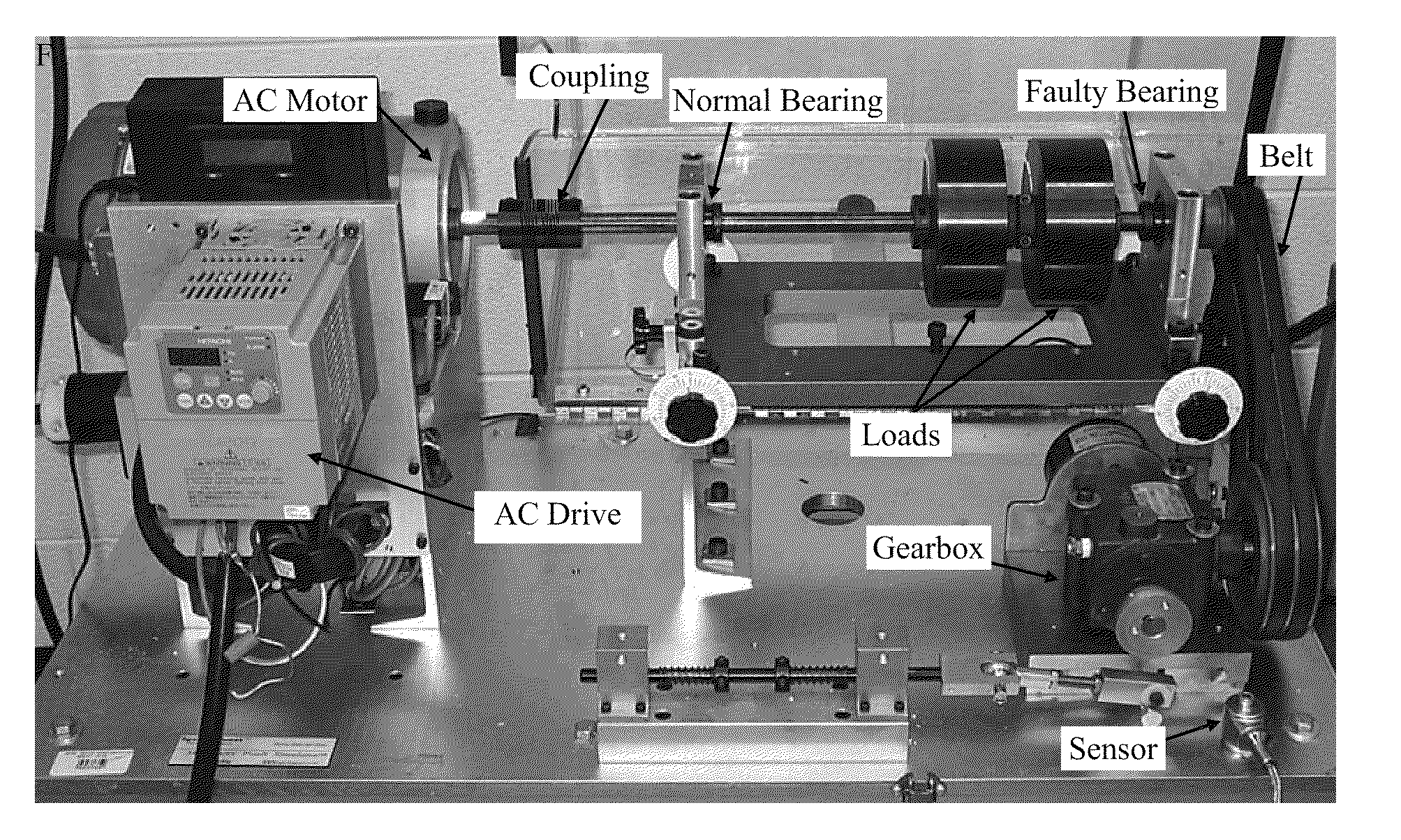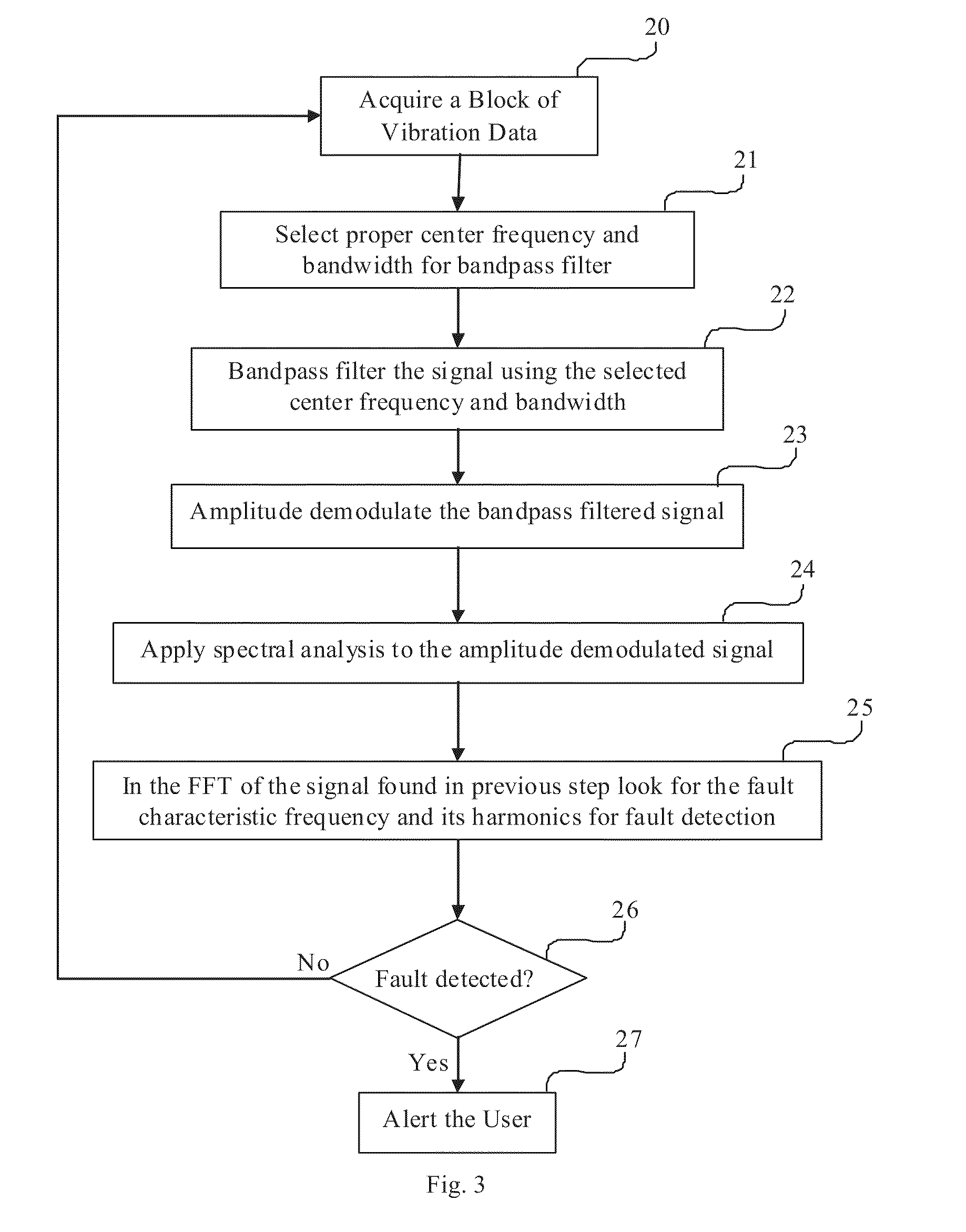Parameter independent detection of rotating machinery faults
a technology of rotating machinery and fault detection, applied in the direction of machine part testing, material analysis using acoustic emission techniques, processing detected response signals, etc., can solve the problems of unplanned productivity loss for production facilities or catastrophic consequences for mission-critical equipment, failure of rolling-element bearings, and complete stalling of mechanical systems. , to achieve the effect of efficient implementation
- Summary
- Abstract
- Description
- Claims
- Application Information
AI Technical Summary
Benefits of technology
Problems solved by technology
Method used
Image
Examples
experiment i
[0068]Referring to FIG. 7, the mechanical system of experiment I, which incorporates a faulty outer-race bearing is illustrated. Experiment I was conducted using a SpectraQuest Machinery Fault Simulator (MFK-PK5M). Attached to the simulator were two well balanced mass rotors (2″ thick, 4″ in diameter and 11.1 lbs each) installed on a ⅝″ steel shaft and supported by two type ER10K bearings (inside, outside, pitch and ball diameters are respectively 0.6250″, 1.8500″, 1.3190″ and 0.3125″) with eight rolling elements (balls). The simulator was powered by a 3-hp AC motor which was controlled by a Hitachi drive (SJ200-022NFU). The shaft speed was set at 1422 RPM (23.7 Hz). The right bearing had a pre-seeded fault created by the manufacturer on the outer race with a characteristic frequency of 72 Hz, as specified in the simulator user's manual. To create additional vibration interference, a gearbox was also connected to the driving shaft using a belt.
[0069]In experiment I, an accelerometer...
experiment ii
[0073]Referring to FIG. 10, the mechanical system of experiment II, driven by an AC motor incorporating a faulty inner-race bearing is illustrated. An AC motor bearing of type NSK-6203 (inside, outside, pitch and ball diameters are respectively 0.6693″, 1.5748″, 1.142″ and 0.266″) with eight rolling elements (balls) was used. A single balanced load rotor (2″ thick, 4″ in diameter and 11.1 lbs) was mounted on the same ⅝″ steel shaft which was used in experiment I. Both bearings that supported the shaft were normal. To introduce additional vibration interferences, two unbalanced rotors were also installed on the ⅝″ steel shaft, as well as a gearbox via a belt connection. The shaft speed was set at 1428 RPM (23.8 Hz). The AC motor bearing had a pre-seeded fault, which was created by the manufacturer on the inner race with a characteristic frequency of 117 Hz.
[0074]In experiment II, the raw vibration sensor data was acquired from the vibration sensor in the same fashion as in experiment...
experiment iii
[0077]The mechanical system of experiment III is illustrated in FIG. 13. This experiment was for a two stage parallel gearbox incorporating a faulty output gear. The faults of the output gear include dented and chipped teeth. Referring to the same figure, the input gear has 24 teeth. This gear engages with a 40 teeth intermediate gear, labeled as “Intermediate 1” in FIG. 13(b), leading to a speed reduction of 0.6. The second intermediate gear, labeled as “Intermediate 2” in FIG. 13(b), has 32 teeth and was engaged to a 96 teeth output gear. Hence, the total speed reduction was 0.2. The output shaft was connected to a Precision Tork™-Model MC6 magnetic break providing 4.7 N.m load. The same accelerometer (Montronix VS100-100) as that used in experiments I and II was placed on the casing of the gearbox, as illustrated in FIG. 13(a).
[0078]In this experiment, the shaft rotational speed was 3.54 Hz, which lead to fundamental harmonics of 3.54 Hz, 2.12 Hz, and 0.71 Hz for the input, inter...
PUM
 Login to View More
Login to View More Abstract
Description
Claims
Application Information
 Login to View More
Login to View More - R&D
- Intellectual Property
- Life Sciences
- Materials
- Tech Scout
- Unparalleled Data Quality
- Higher Quality Content
- 60% Fewer Hallucinations
Browse by: Latest US Patents, China's latest patents, Technical Efficacy Thesaurus, Application Domain, Technology Topic, Popular Technical Reports.
© 2025 PatSnap. All rights reserved.Legal|Privacy policy|Modern Slavery Act Transparency Statement|Sitemap|About US| Contact US: help@patsnap.com



